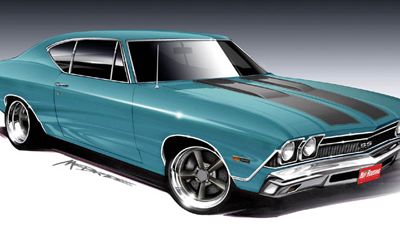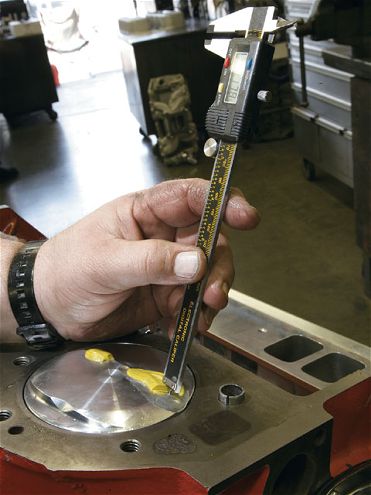
In terms of heavy ordinance, a Howitzer is a big gun designed to do damage by propelling a large projectile with a seriously unruly velocity. The aim of our big-block Chevrolet build is to achieve a very similar goal, but with Hunkins' '68 Chevelle playing the part of the projectile. Moving a big street machine in heavy-hitting fashion is best done with a heavy-hitting powerplant. You can read that as big on cubes, big on torque, and, of course, big on power. Those three characteristics pretty much define the objectives of our Howitzer 496 stroker. Our goal was to build the engine using quality parts on a realistic working man's budget, which may be a little more than what an odd-jobber or alley-dwelling wino can spend, but a lot less than many cost-no-object builds we've seen.
The 496 big-block Chevy stroker has become a popular combination, based on a 454 block bored .060 inch, and fitted with an aftermarket crankshaft with an increase in stroke to 4.250 inch from the factory 4.00 inch. Frankly, when the engine is receiving a full rebuild, that quarter-inch of stroke comes mighty cheap. Our Scat rotating assembly retails at $1,268 when sourced from Survival Motorsports, and includes a cast-steel crank, I-beam rods, SRP domed pistons, JE rings, and Clevite bearings. Not a bad deal for most of the bottom-end hard parts, and a real bargain considering the extra 36 cubes bagged in the deal. When considering to build a fresh 454 with new rods and pistons, the ante is just not that much more to step up to a full 496 rotating assembly and let those extra cubes work.
Of course, more cubes naturally have a heartier appetite for air, so taking advantage of the displacement increase means a healthy set of cylinder heads. We knew that we wanted a set of aftermarket aluminum heads. Though there are some good iron heads on the market, the weight advantage of aluminum is a definite plus when considering the conspicuous heft of an all-iron big-block. Before jumping off the deep end, it pays to have a set objective in mind when shopping the virtually unlimited range of big-block Chevy cylinder heads. Our notion was to build a torquey pump-gas street piece, not an all-out drag engine. We would select a hydraulic roller cam for long-term durability and low maintenance. The cam selection, along with the moderate street bottom end, dictates a maximum reliable engine speed between 6,000 and 6,500 rpm-not 7,000-plus rpm. For this max rpm range, a moderate performance cylinder head would serve the engine's needs handily. We went with the Racing Head Service 320cc (intake runner) heads. At just over $1,800 (per pair, assembled), these heads are reasonably priced, and with over 350 cfm of max airflow on hand, we had more than enough air to make power in our street combination.
A stroker with nearly 500 ci will naturally produce torque in abundance, and torque would be key to effortlessly heaving the Street Sweeper Chevelle. We decided not to fight the natural tendency for torque, but instead sought to maximize it in the rest of our parts selection. To complement the cylinder heads, an Edelbrock Performer RPM Air Gap intake was selected. A two-plane with 180-degree runner separation and ample runner length will always have a torque advantage in the low- to mid-range compared to a single-plane. The Air Gap is about as good as it gets in terms of out-of-the-box flow from a two-plane, and the divorced runners maintain a cooler, more powerful fuel/air charge. Ensuring adequate air with fuel mixed in the proper proportion, we coupled the manifold to an 850 cfm Mighty Demon carb. Sure, a single-plane would likely bring in a higher peak horsepower number at the top of the rpm range, and many builders will make that trade. Our plan was to go for the fatter torque curve over a wider portion of the engine's operating range, and retain the stock flat hood in the deal.
Similarly, when it came time to select the camshaft, we had a few alternatives. A hydraulic roller has just too much going for it to pass it up in this type of application, particularly in a big stroker that doesn't need extreme rpm to make power. Few will argue the reliability advantage of a hydraulic roller in comparison to a solid roller or a flat-tappet design. While either of the alternative solids can provide the benefit of easier high-rpm potential, the beauty of a stroker is that you don't have to go there to reap its performance rewards. As with the rest of the combination, we were looking for a camshaft profile that would come on with strong torque, and yet pull without argument to the 6,000 rpm range.
A relatively narrow lobe separation is key for brutal, hard-hitting mid-range torque, while plenty of overlap and extra exhaust duration is the usual call for making an engine hang on into the higher revs. We found both of these qualities in COMP's new Thumpr line of camshafts. A COMP Big Mutha Thumpr (BMT) PN 11-602-8 stick got the nod, which is an off-the-shelf grind featuring 243/257 degrees of duration at .050 inch, .570/.554-inch lift, and a tight 107-degree lobe separation angle. To make the most of the camshaft, a reliable valvetrain was assembled with components from COMP, including COMP's retrofit hydraulic roller lifters to fit out a Mark IV block, COMP Hi-Tech 3/8-inch pushrods, and aluminum 1.7:1 roller rockers. A final trick to really make the big engine spin to its full potential was to specify COMP's Beehive valvesprings on those RHS cylinder heads. RHS obliged this request and now features this setup with a dedicated part number (11001-05).
With this, we had our basic combination, and the promise of mega torque. We took the load of parts-including oil system components from Melling, all-new tin from AAMidwest, an MSD HEI setup, and ARP bolts to screw it all together-to Andy Mitchell's Outlaw Racing Engines (Upland, CA). Andy oversaw the assembly, and measured everything to blueprint specs, while Hunkins and Outlaw part-timer Tim Martindale, helped work the nuts and bolts between shooting photographs and cooking ribeyes on the grill. What emerged was a hot-looking 496 that will fit under the stock Chevelle hood, chomping at the chance to prove its stuff come dyno day.
It wasn't long before the big-block was hauled to Westech Performance Group and bolted on a SuperFlow 902 dyno to validate the combination. Dyno master Steve Brul performed the preliminary checks of base carb and ignition settings, and the rat fired with authority. With a hydraulic roller combination, the cam break-in drama of a flat tappet is completely sidestepped, but the engine was run through a programmed load cycle to help seat the rings and prepare for the action to come. With a compression ratio of 10.2:1, there was no need to feed the Mighty Demon carb anything but standard-issue pump premium fuel. A few static checks under load helped sort the jetting.
With the formalities out of the way, it was time to let it rip. As the numbers rolled in, the big-block showed its true character. Want to propel a heavy street machine with explosive power? The Howitzer was revealing itself to be the ideal weapon, with a numbing 600 lb-ft churning right from 3,200 rpm, climbing to a peak of 635 lb-ft at 3,800 rpm. Wow, that's a lot of torque, and it comes in right now! We've seen some engines build a lot of low-end torque, only to give up low in the rpm range with no big horsepower bang up top. This isn't the case with The Howitzer. Our big Chevy just kept coming, making power right up to 6,000 rpm, and beyond. Torque recorded over 600 lb-ft right up to 5,300 rpm, and power held strong to the top, recording a peak of 626 hp, coming in at 5,900 rpm. Even past peak, the engine only slowly came off the crest, pulling easily higher. This is an engine that will hit like a cannon out of the hole, and keep pulling like an artillery piece barreling headlong to a shift point just over 6,000 rpm. Our Howitzer is one engine that's earned its name.
Cylinder Head Flow
We found some interesting tidbits when we dug into testing the flow of our new RHS cylinder heads. Only a few issues back (see "The Ironman," July 2007), we used a set of Summit iron cylinder heads, and were more than impressed with the numbers recorded when the machine shop sent them out for testing. What surprised us was that testing the RHS cylinder heads at Westech on its FlowCom-equipped SuperFlow bench showed nearly the same flow. However, we've preached the importance of not taking numbers from two different benches when making comparisons, and were curious enough to re-test the iron heads on the same bench to get a valid comparison. It seems the Westech flowbench is definitely less generous than the bench used to originally test the Summit heads. Testing back-to-back on the same bench gave us a valid set of numbers forthe comparison.

The Howitzer Vs. The Ironman
What's The Diff?
Sharp eyes will notice there's a lot of commonality between The Howitzer and The Ironman, a 468-inch big-block we put together in the July issue. Both engines are one and the same. Sort of. When we put the iron-headed 468 on the dyno and made 579 hp, we decided to go back for a little more power and a little less weight before dropping it into the Chevelle. The primary differences: Swapping the iron Summit 308cc heads for the RHS 320cc aluminum heads, boosting the displacement from 468 inches (basically a stock .060-over 454) to 496 inches using a longer 4.25-inch stroke, and-surprise-stepping back from the brink in the cam department, forsaking a radical-for-the-street .647-inch lift solid roller cam for a street-friendly .570-lift hydraulic roller (COMP's new Big Mutha Thumpr). Another smaller change was a slight increase in carb size from an annular booster 825 Mighty Demon to a downleg booster 850.
The Ironman 468 made 579 hp at 6,200 rpm and 545 lb-ft of twist at 4,200 rpm, and had a build-it-yourself price of $6,633.09. We were initially concerned that the stroked 496 might blow the budget with a more expensive set of aluminum heads, but the calculator only registers another $890.28 over the Ironman's price, and produced 47 more hp and another 90 lb-ft of torque (coming in 400 rpm earlier). We like that trade-especially with the weight savings-and we're glad we made it. Andy Mitchell of Outlaw Racing says he can build The Howitzer for you just like this for about $1,500 over the do-it-yourself price we're listing, and interested parties should call him at 909-931-4612.
37 degrees ignition timing82/90 jets